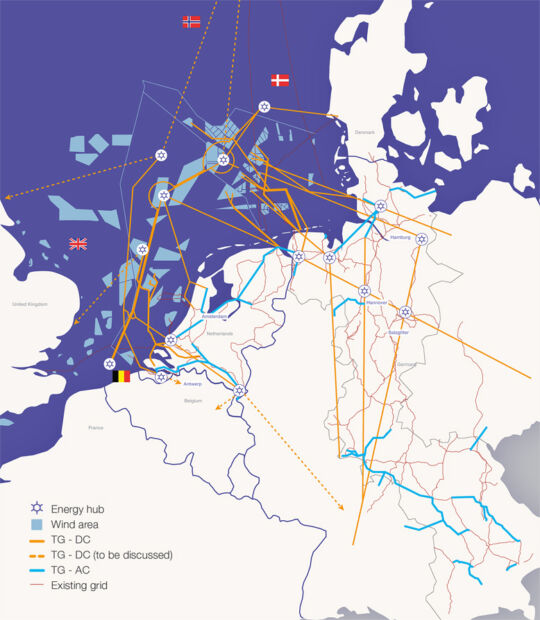Tennet vision for electricity grid in 2045
- April 25, 2023
- Steve Rogerson

Dutch-German transmission system operator (TSO) Tennet has presented Target Grid, its vision for the electricity grid of 2045.
The approach is designed to cope with the challenges of energy transition. The objective is to have an electricity grid in place by 2045 for a flourishing, sustainable economy, always with enough green electricity for everyone, ranging from consumer to industry.
The initial version of Target Grid, including the associated grid map for 2045, was presented this month to the Dutch minister for climate and energy policy, Rob Jetten.
With Target Grid, Tennet is proposing a network of DC (direct current) superhighways and energy hubs, the DC grid (electricity superhighways), and an improved existing AC (alternating current) grid. This combination of energy hubs connected by superhighways should ensure that renewable electricity can be transported long distances from the North Sea to consumers and industry, and that the electricity grid remains reliable. The handover to Jetten marks the start of a dialogue with all stakeholders to shape the Target Grid together.
Germany and the Netherlands are faced with similar difficulties: more than a doubling of electricity consumption, five to ten times larger generation capacity, significant levels of required flexibility and, for each country, approximately 70GW of offshore wind energy that has to reach industries and households in Dutch, German and other European countries as efficiently as possible.
Getting these large volumes of electricity to the right place will require a different approach to realise the high-voltage grid of the future in a timely manner.
“The world in which we operate as an electricity transmission system operator is rapidly changing,” said Manon van Beek, Tennet CEO. “For the first time, on the basis of political objectives for climate neutrality, we have created a view of the energy system for 2045 and the associated electricity grid, Target Grid. Our infrastructure is crucial to such a degree that we are putting it in the driver’s seat, so to speak, so that Tennet can start working on what is needed on time, rather than ten or fifteen years from now when it is too late. We can no longer afford to work at a defined pace from bottleneck to bottleneck. For grid development – onshore and offshore – at this scale and in a European context 2030 is tomorrow, 2040 is next week and 2050 is next month.”
Target Grid is based on the highest electrification scenarios of the Dutch II3050 (Integrated Infrastructure Survey 2030-2050) and the German NEP2023 (Grid Development Plan). As a result, the Netherlands and large parts of Germany will end up having a network configured to support a fully renewable energy system, which is sufficiently robust to ensure security of supply. Target Grid makes it possible for the North Sea to become a genuinely sustainable green hub for the supply of electrons at the heart of the European energy transition.
Target Grid is focused on as efficiently and effectively accessing the North Sea as the most important source of renewable electricity for the Netherlands, Germany and the north-western European region.
Germany will need its offshore capacity (70GW) for domestic electrification. Because at 52GW offshore wind capacity, the Netherlands can meet its domestic needs for electricity and hydrogen, its projected 72GW offshore wind capacity and its connections with other countries give it additional opportunities and advantages. At reduced wind conditions, the security of supply for Dutch households, the business community and industry remains high, and, at strong wind conditions, economic benefits can be obtained on the electricity and hydrogen markets. At some times, the Netherlands will export electricity and at other times it will import electricity, just as it does today.
With the presentation of Target Grid, Tennet is kicking off a dialogue with stakeholders aiming to develop Target Grid. Five principles are of basic importance here. First, the development of an unambiguous North Sea country strategy for 2050 with clear agreements between the North Sea countries. Also, additional location policy is required to develop demand centres for energy at the right locations. Next, timely licensing is essential to develop the energy corridors Tennet has included in Target Grid. In addition, an adjustment of the electricity market model is recommended to facilitate the cross-border exchange of electricity from offshore wind and to share the costs for this.
Finally, Tennet sees the supply chain for critical infrastructure components coming under pressure given the high offshore wind ambitions in the world and the limited supply of critical components, availability of dockyards, installation vessels and manpower. Tennet recommends a European coordinated strategy to ensure sufficient and, through the years, stable supply chain capacity.





